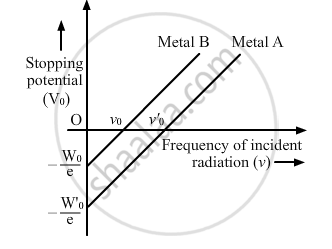Advertisements
Advertisements
Question
The photoelectric work function for a metal surface is 2.3 eV. If the light of wavelength 6800A is incident on the surface of metal, find threshold frequency and incident frequency. Will there be an emission of photoelectrons or not?
[Velocity of light c = 3 x 108 m/s,
Planck’s constant, h = 6.63 * 10-34 Js ]
Solution
Given:
`phi_0=2.3 eV=2.3*1.6*10^-19 J=3.68*10^-19J`
λ=6800 Å=6800*10-10m, c=3*108 m/s, h=6.63*10-34 Js
We know that the incident frequency is given as
`v=c/lambda`
∴`v=(3*10^8)/(6800*10^-10)=4.41*10^14Hz`
Now, if the incident frequency is greater than the threshold frequency, then photoelectrons will be emitted from the metal surface. The threshold frequency is given from work function as
`v_0=phi_0/h`
`v_0=(3.68*10^-19)/(6.63*10^-34)=5.55*10^14Hz`
Since, photoelectrons `v<v_0` will not be emitted.
APPEARS IN
RELATED QUESTIONS
Draw a neat labelled circuit diagram of experimental arrangement for study of photoelectric effect.
Sketch the graphs showing variation of stopping potential with frequency of incident radiations for two photosensitive materials A and B having threshold frequencies vA > vB.
(i) In which case is the stopping potential more and why?
(ii) Does the slope of the graph depend on the nature of the material used? Explain.
The photoelectric work function for a metal is 4.2 eV. If the stopping potential is 3V, find the threshold wavelength and maximum kinetic energy of emitted electrons.
(Velocity of light in air = 3 x 108m/s,
Planck's constant = 6·63 x10-34 J -s,
Charg.e ori electron = 1·6 x 10 -19 C)
Light of intensity ‘I’ and frequency ‘v’ is incident on a photosensitive surface and causes photoelectric emission. What will be the effect on anode current when (i) the intensity of light is gradually increased. In each case, all other factors remain the same. Explain, giving justification in each case.
Light of intensity ‘I’ and frequency ‘v’ is incident on a photosensitive surface and causes photoelectric emission. What will be the effect on anode current when the anode potential is increased? In each case, all other factors remain the same. Explain, giving justification in each case.
Draw a plot showing the variation of photoelectric current versus the intensity of incident radiation on a given photosensitive surface.
The graph shows the variation of stopping potential with frequency of incident radiation for two photosensitive metals A and B. Which one of the two has higher value of work-function? Justify your answer.

If the total energy of radiation of frequency 1014 Hz is 6.63 J, calculate the number of photons in the radiation. (Planck’s constant = 6.63 x 10–34 J.s.)
A photosensitive surface emits photoelectrons when red light falls on it. Will the surface emit photoelectrons when blue light is incident on it? Give reason.
Draw a plot showing the variation of photoelectric current with collector potential for different frequencies but same intensity of incident radiation ?
Use Einstein's photoelectric equation to explain the observations from this graph ?
A beam of monochromatic radiation is incident on a photosensitive surface. Answer the following question giving reason :
Do the emitted photoelectrons have the same kinetic energy?
In photoelectric effect, why should the photoelectric current increase as the intensity of monochromatic radiation incident on a photosensitive surface is increased? Explain.
What is photoelectri effect ? Defin (i) Stopping potential (ii) Photoelectric work function.
Calculate the momentum of a photon of energy 6 x I 0-19 J.
Plot a labelled graph of IVsl where Vs is stopping potential versus frequency f of the incident radiation.
State how will you use this graph to detennine the value of Planck's constant.
If the frequency of the incident radiation is increased from 4 × 1015 Hz to 8 × 1015 Hz, by how much will the stopping potential for a given photosensitive surface go up?
Photoelectric effect is possible ______.
Light of wavelength 4000 Å is incident on two metals A and B. Which metal will emit photoelectrons, if their work functions are 3.8 e V and 1.6 e V respectively?
